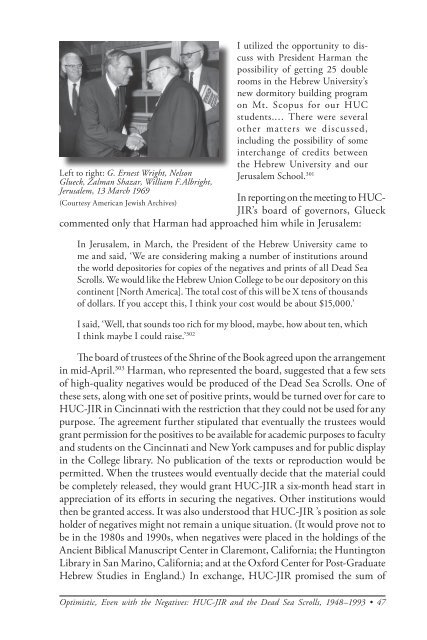The American Jewish Archives Journal, Volume LXI 2009, Number 1
The American Jewish Archives Journal, Volume LXI 2009, Number 1
The American Jewish Archives Journal, Volume LXI 2009, Number 1
Create successful ePaper yourself
Turn your PDF publications into a flip-book with our unique Google optimized e-Paper software.
Left to right: G. Ernest Wright, Nelson<br />
Glueck, Zalman Shazar, William F.Albright,<br />
Jerusalem, 13 March 1969<br />
(Courtesy <strong>American</strong> <strong>Jewish</strong> <strong>Archives</strong>)<br />
I utilized the opportunity to discuss<br />
with President Harman the<br />
possibility of getting 25 double<br />
rooms in the Hebrew University’s<br />
new dormitory building program<br />
on Mt. Scopus for our HUC<br />
students.… <strong>The</strong>re were several<br />
other matters we discussed,<br />
including the possibility of some<br />
interchange of credits between<br />
the Hebrew University and our<br />
Jerusalem School. 301<br />
In reporting on the meeting to HUC-<br />
JIR’s board of governors, Glueck<br />
commented only that Harman had approached him while in Jerusalem:<br />
In Jerusalem, in March, the President of the Hebrew University came to<br />
me and said, ‘We are considering making a number of institutions around<br />
the world depositories for copies of the negatives and prints of all Dead Sea<br />
Scrolls. We would like the Hebrew Union College to be our depository on this<br />
continent [North America]. <strong>The</strong> total cost of this will be X tens of thousands<br />
of dollars. If you accept this, I think your cost would be about $15,000.’<br />
I said, ‘Well, that sounds too rich for my blood, maybe, how about ten, which<br />
I think maybe I could raise.’ 302<br />
<strong>The</strong> board of trustees of the Shrine of the Book agreed upon the arrangement<br />
in mid-April. 303 Harman, who represented the board, suggested that a few sets<br />
of high-quality negatives would be produced of the Dead Sea Scrolls. One of<br />
these sets, along with one set of positive prints, would be turned over for care to<br />
HUC-JIR in Cincinnati with the restriction that they could not be used for any<br />
purpose. <strong>The</strong> agreement further stipulated that eventually the trustees would<br />
grant permission for the positives to be available for academic purposes to faculty<br />
and students on the Cincinnati and New York campuses and for public display<br />
in the College library. No publication of the texts or reproduction would be<br />
permitted. When the trustees would eventually decide that the material could<br />
be completely released, they would grant HUC-JIR a six-month head start in<br />
appreciation of its efforts in securing the negatives. Other institutions would<br />
then be granted access. It was also understood that HUC-JIR ’s position as sole<br />
holder of negatives might not remain a unique situation. (It would prove not to<br />
be in the 1980s and 1990s, when negatives were placed in the holdings of the<br />
Ancient Biblical Manuscript Center in Claremont, California; the Huntington<br />
Library in San Marino, California; and at the Oxford Center for Post-Graduate<br />
Hebrew Studies in England.) In exchange, HUC-JIR promised the sum of<br />
Optimistic, Even with the Negatives: HUC-JIR and the Dead Sea Scrolls, 1948–1993 • 47

















